Do you notice your gutter downspout is so filled with debris, it’s completely clogged? You’re probably wondering what to do. Keep reading to learn your different options.
Don’t Wait

Homeowners usually have a long list of spring-cleaning chores. For some, clearing gutters are at the top of the list. Good job!
Cleaning gutters and downspouts at least twice each year is ideal.
Cleaning in the fall after your trees shed the last of their leaves and cleaning in the spring after the last of the snow and ice melts are monumental times for cleaning systems.
At the time of cleaning, with the debris removed, you will then have greater visibility on any problem areas. Gutter debris is easily seen, but you don’t always know what’s stuck in downspouts and drains buried underground.
Regular cleanings helps eliminate clogged gutters and downspouts. It also helps reduce corrosion from rust.
Clean, rust-free gutters last longer so block out a Saturday and grab your gloves!
The Art of Gutter Maintenance
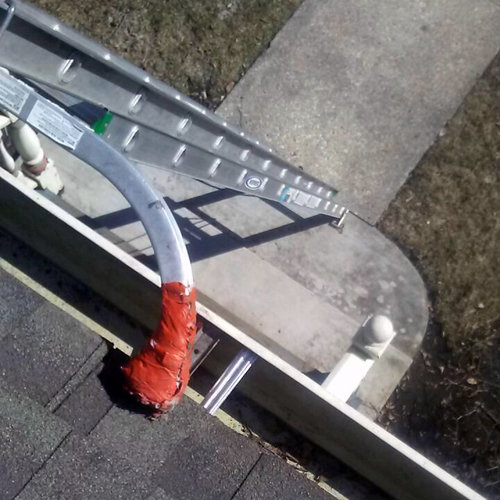
Gutter cleaning does take a certain finesse.
Starting with the ladder, you want to make sure you don’t use the ricketiest ladder in the garage. For gutter protection, be careful that you don’t rest the ladder up against gutters as gutters are susceptible to dents. Try a ladder stabilizer.
While you’re in the garage, grab your rake, your garden hose and a pistol grip trigger spray nozzle.
Before you get to the gutters and downspouts, use the rake and hose to clear the roof. This is a great time to clean off any moss and other debris from the roof. If you don’t do this step, the next time it rains, all that debris will flow down into the gutters.
Next, put on sturdy work gloves. This will protect your hands not only from scratches and cuts but from bacteria.
For safety reasons, you don’t want your bare hands digging around where critters nest.
If this doesn’t sound like a fun weekend activity, call a professional and make things easier on yourself.
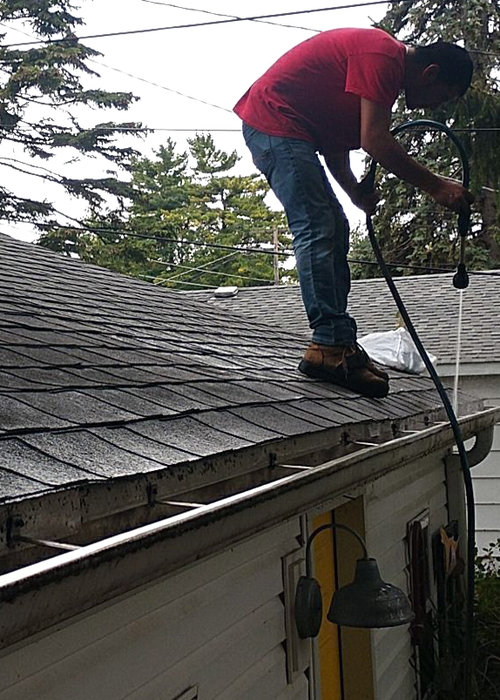
I Think I Might Have a Clog
Even people who faithfully clean their gutters get a clog every now and then.
The obvious sign of a clog is water flowing over the gutters. Sheets of water spilling over gutters means a dam exists either in the gutter or in the downspout.
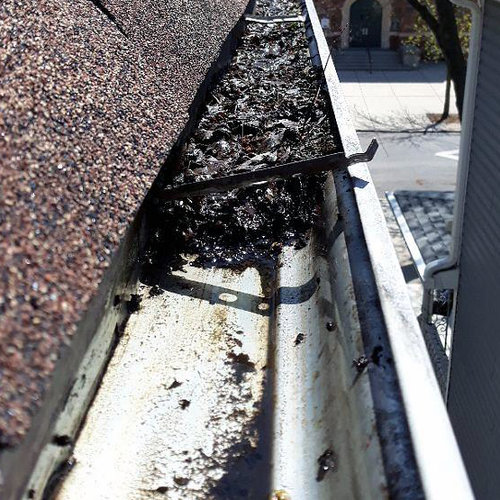
Another sign of a clogged gutter is nothing flowing from your downspout during snowmelt or a rainstorm. If you notice a lack of water draining during early spring, you may have ice that hasn’t melted in a downspout.
If your downspouts are dry while the rest of the neighborhood is experiencing Niagara Falls, you have a problem! Don’t ignore it. Water that doesn’t drain properly away from the roof usually ends up seeping through walls and ceilings.
Clearing Gutter Downspout Clogs 101
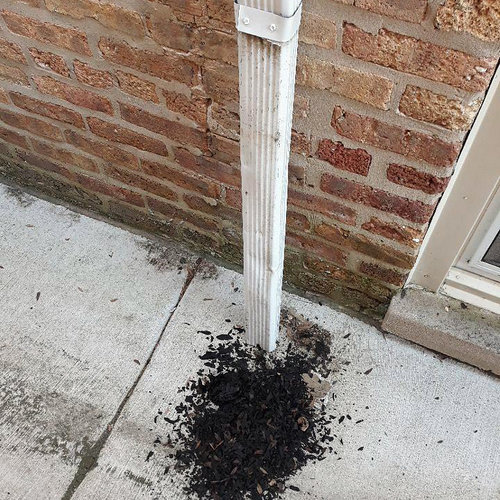
No scare tactics intended but the last thing you want is a costly repair bill due t o water damage caused by a clogged gutter system.
The good news is you likely have a small object or a cluster of leaves and twigs clogging up a downspout. This is a relatively easy fix because you simply disconnect the downspout from the drain at the bottom and force water into it from the garden hose.
You might need to give it a few strong taps, but the clog should dislodge.
If the hose doesn’t do the trick, try a plumbing snake. If that doesn’t work, you’ll need to take the downspout off and take it apart. This gives you better access to the clog.
Hint: If the downspout connects to an underground drain, disconnect the downspout from the drain. Otherwise, you risk pushing the clog into the underground drain.
Once you go through these maneuvers, clear the gutters with the hose so you can avoid any remaining debris creating another clog.
Clogs Underground
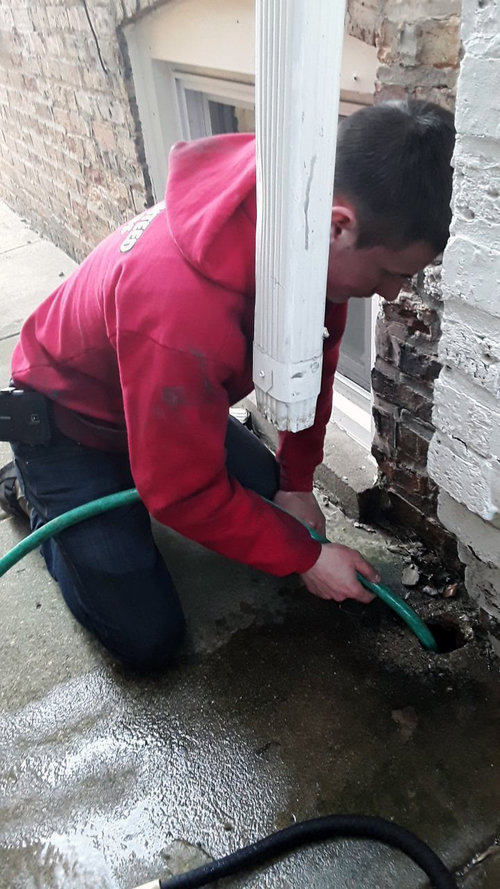
Clogs also form in buried drainpipes. While gutters and downspouts help control runoff from your roof, they’re not effective if water isn’t moved far enough from your home’s foundation.
Homeowners often use a series of buried drainpipes connected to downspouts. This set-up helps avoid water from collecting near the foundation. Many basements are saved from water damage every year because homeowners use these tactics.
If you have a back-up in a buried gutter downspout you have your work cut out for you. Buried drainpipes drain to one of the following:
- Main storm sewer
- Daylight
- Drywell
Daylight refers to a point lower than your house. It’s usually a spot in the yard where water flows out at grade level. If you have a daylighted drain, you should see the end of it sticking out in the grass.
A dry well is filled with gravel, which allows water to percolate into the soil.
You can usually clear clogs in buried drainpipes by flushing them out with a hose. If not, you probably have a more extensive clog than you can handle with simple home maintenance tools.
At this point, calling a gutter downspout cleaner saves you headaches and could save you some money.
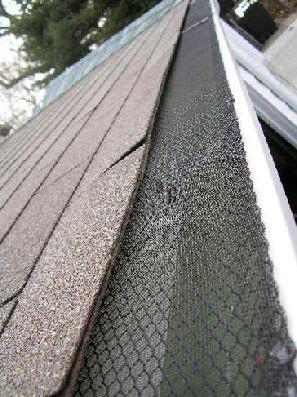
Cover Up Those Gutters
As you can see, gutters and downspouts develop clogs for a variety of reasons.
Whether it’s an overabundance of leaves in the fall or accumulations of snow and ice in the winter, gutters take quite a beating. Added to natural causes are animals who find a welcome place to build nests and take up residence.
Consider adding gutter covers this year. Gutter covers, also called gutter guards, fit directly into your gutters. They protect gutters from accumulations of leaves and blossoms from flowering trees all while discouraging animals from building nests in gutters.
In areas of the country with extremely cold winter temperatures, you can also add heat to gutters and prevent ice dams.
Need Help with a Clogged Gutter?
Hopefully, this post helped you understand what to do if you have a clogged gutter system.
Of course, the best thing you as a homeowner can do is avoid gutter downspout clogs in the first place. The best way to do that is to schedule routine gutter cleanings.
If you’re one of the many homeowners who prefer not to climb ladders, or if you simply don’t have time, let a professional take care of this task for you.
Contact us today and let’s get you on the schedule for gutter maintenance.

